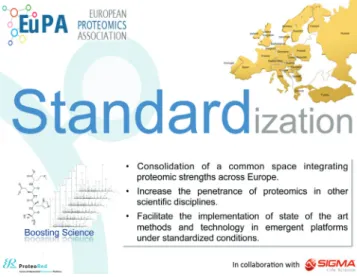HAL Id: hal-03080121
https://hal.archives-ouvertes.fr/hal-03080121
Submitted on 17 Dec 2020
HAL is a multi-disciplinary open access
archive for the deposit and dissemination of
sci-entific research documents, whether they are
pub-lished or not. The documents may come from
teaching and research institutions in France or
abroad, or from public or private research centers.
L’archive ouverte pluridisciplinaire HAL, est
destinée au dépôt et à la diffusion de documents
scientifiques de niveau recherche, publiés ou non,
émanant des établissements d’enseignement et de
recherche français ou étrangers, des laboratoires
publics ou privés.
The EuPA Standardization Initiative
F. Canals, F. Elortza, A. Paradela, G. Corthals, Michelle Camenzuli, A.
Muñoz, O. Schiltz, Anne Gonzalez de Peredo, A Sickman, C. Borchers, et al.
To cite this version:
F. Canals, F. Elortza, A. Paradela, G. Corthals, Michelle Camenzuli, et al.. The EuPA Standardization
Initiative. EuPA Open Proteomics, Elsevier, 2016, 11, pp.31-32. �10.1016/j.euprot.2016.03.007�.
�hal-03080121�
E u PA O P E N P R O T E O M I C S 1 1 ( 2 0 1 6 ) 3 1 - 3 2
Av a i l a b l e o n l i n e a t w w w . s c i e n c e d i r e c t . c o m
j o u r n a l h o m e p a g e : h t p p : / / w w w . e l s e v i e r. c o m / l o c a t e / e u p r o t
ScienceDirect
http://dx.doi.org/10.1016/j.euprot.2016.03.007
The EuPA Standardization Initiative
Mass spectrometry has experienced huge advances in the lastdecade increasing the coverage, accuracy and capacity of pro-tein/peptide measurements in complex biological samples. The ability to massively identify and quantify proteins places proteomics as one of the most valuable analytical resources to such measurements, leading to a better understanding of sophisticated cellular processes at the functional level. To increase accuracy and enable inter- and intra-laboratory ex-perimental comparisons, reliability, robustness and reproduc-ibility must be possible and embedded in the technology. To this end, it is critical to defi ne quality control procedures and standardized protocols for the whole proteomics workfl ow, from sample collection and preparation to data collection and computational analysis and fi nally data exchange.
The EuPA Standardization initiative (Figure 1) is of utmost importance since standardization of proteomics workfl ows will promote the consolidation of a common space, integrat-ing proteomic strengths across Europe, based on the easy exchange of information generated according to normalized protocols based on standardized data formats. Besides im-proving the effi ciency within the proteomics environment, standardization is crucial to increase the impact and rele-vance of proteomics in other scientifi c disciplines. It is impor-tant to note that the translation of analytical results into rel-evant biological knowledge and practical applications is often hampered by the lack of standardized protocols that emerge, therefore, as an urgent need.
The overall aim of this initiative is the organization of multi-laboratory studies to:
• Evaluate protocols, protocol variants, workfl ows and data processing procedures to assess reproducibility, robustness and technical limits. Optimization of ex-isting protocols. Interaction with potential industrial partners; the collaboration with SIGMA has been re-markable in previous standardization initiatives and their participation has been already agreed. (Other ef-forts to strengthen our initiatives are welcome). • Deliver protocols of common proteomics procedures
under standardized conditions. Defi nition of standard operation procedures (SOPs), limit of detection (LOD), limit of quantifi cation (LOQ). Ensure open access and communication with existing and ongoing HUPO-PSI. Easy exchange of technology and results across labo-ratories.
• Facilitate the implementation of standardized proto-cols in current and emergent facilities with limited experience and scope. Methods for self-performance evaluation.
Milestones
• Annual strategic discussions to defi ne the study. • Reference sample preparation.
• Call for participants via EuPA network. • Sample distribution.
• Analysis of the results.
• Meeting for presentation and discussion of the results. • Creation of a repository of standardized protocols
publicly accessible from the EuPA web page. Deliverables
• Study proposal. Description, guidelines and recom-mendations. Publication on the EuPA web page [www. eupa.org].
• Intermediate report and congress submission. • Publication of the results and main conclusions. • Standardized protocol posted on the EuPA web page.
Figure 1. Launching of the EuPA Standardization Initiative.
Communicated by: F. Canals [fcanals@vhio.net] (Vall d’Hebron Oncology Insti-tute. ProteoRed, Spain) F. Elortza [felortza@cicbiogune.es] (CIC bioGUNE. ProteoRed,
Spain) A. Paradela [Alberto.Paradela@cnb.csic.es] (National Biotech-nology Center. ProteoRed, Spain) G. Corthals [G.L.Corthals@uva.nl] & Michelle Camenzuli
3 2 eup a o p e n p r o t e o m i c s 1 1 ( 2 0 1 6 ) 3 1 – 3 2
[M.Camenzuli@uva.nl] (Van’t Hoff Institute for Molecular Sci-ences, University of Amsterdam, The Nederlands) A. Muñoz [Amalia.MUNOZ-PINEIRO@ec.europa.eu] (Institute for Reference Materials and References (JRC-IRMM), Belgium)
O. Schiltz [Odile.Schiltz@ipbs.fr] & Anne Gonzalez de Peredo [Anne.Gonzalez-de-Peredo@ipbs.fr] (IPBS, CNRS, ProFI, France)
A Sickman [albert.sickmann@isas.de] & C. Borchers [Chris-toph@proteincentre.com], Leibniz Institut für Analytische
Wissenschaften, Germany Fernando J. Corrales [fjcorrales@unav.es] (CIMA, University of
